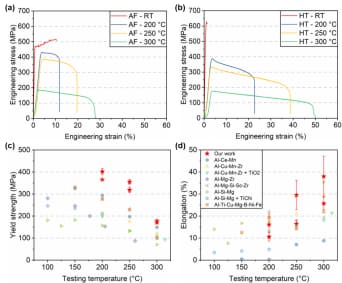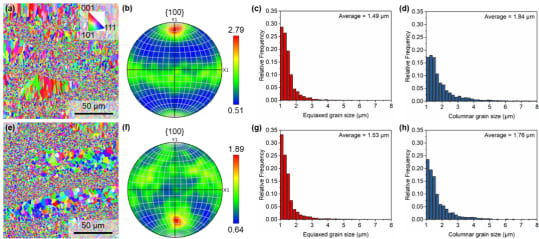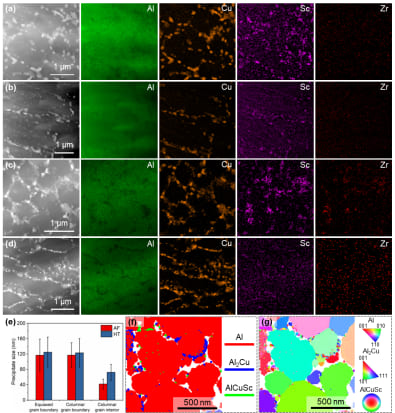Commercially cast and forged aluminum alloys are prone to coarsening or dissolution under conditions above 200 ℃. By utilizing Spherical Aluminum Alloy Powder in Laser Powder Bed Fusion (LPBF), which offers an exceptionally fast cooling rate (105~107 ℃/s), it becomes possible to fabricate new aluminum alloys that exhibit exceptional high-temperature performance. By utilizing rapid cooling, LPBF prevents the formation of detrimental phases, increases the content of phases resistant to coarsening, and enhances mechanical strength.
Mechanical properties of as-fabricated (AF) and heat-treated (HT) samples of Al-Cu-Li-Sc-Zr alloy prepared by LPBF: (a, b) tensile curves at different testing temperatures for AF and HT samples; (c, d) comparison of high-temperature performance with other LPBF-prepared aluminum alloys.

EBSD results of AF (a ~ d) and HT (e ~ f) samples: (a, e) grain orientation maps; (b, f) pole figures; (c, g) grain size statistics of equiaxed grains; (d, h) grain size statistics of columnar grains.

TEM-EDS images: (a) Equiaxed grain region of AF sample, (b) Columnar grain region of AF sample, (c) Equiaxed grain region of HT sample, (d) Columnar grain region of HT sample; (e) Size distribution of precipitates; EBSD-TKD results of equiaxed grain region of AF sample: (f) Phase map and (g) Grain orientation map.

LPBF-fabricated Al-Cu-Li-Sc-Zr alloy showed minimal grain coarsening after high-temperature treatment. The slight increase in grain boundary precipitate size in the HT samples led to a small reduction in yield strength compared to AF samples. However, the low diffusion coefficients of copper, scandium, and zirconium in aluminum prevented significant coarsening. The HT samples exhibited increased high-temperature elongation due to superplasticity, attributed to a higher volume fraction of precipitates. This superior elongation was observed in the presence of second-phase precipitates in the HT samples compared to the AF samples.

The excellent high-temperature tensile performance of Al-Cu-Li-Sc-Zr alloy prepared by LPBF is mainly attributed to its outstanding resistance to grain coarsening and thermal stability of precipitated phases. The former is due to the enrichment effect of precipitated phases at grain boundaries, providing an excellent grain boundary pinning effect. The latter is attributed to the limited diffusion rate of alloy elements. The research results contribute to the advancement of the design and preparation of additive manufacturing aluminum alloys for high-temperature applications.
Heeger Materials is a reputable supplier offering Spherical Aluminum Alloy Powder and other high-quality Spherical Powder products at competitive prices, which are widely used in the 3D printed industry and other research and science fields. If you're interested, feel free to contact us at [email protected] for a quote, and we guarantee a response within 24 hours.


